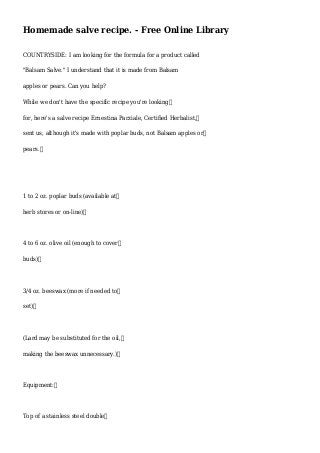
Homemade salve recipe. - Free Online Library
- 1. Homemade salve recipe. - Free Online Library COUNTRYSIDE: I am looking for the formula for a product called "Balsam Salve." I understand that it is made from Balsam apples or pears. Can you help? While we don't have the specific recipe you're looking for, here's a salve recipe Ernestina Parziale, Certified Herbalist, sent us, although it's made with poplar buds, not Balsam apples or pears. 1 to 2 oz. poplar buds (available at herb stores or on-line) 4 to 6 oz. olive oil (enough to cover buds) 3/4 oz. beeswax (more if needed to set) (Lard may be substituted for the oil, making the beeswax unnecessary.) Equipment: Top of a stainless steel double
- 2. boiler Electric skillet Cooking thermometer Largemouth jar or suitable container for the salve Place buds in the top of a double boiler covered with oil. Set the pan in the center of the electric skillet with the thermometer clipped to the inside and resting in the oil. Place about 1/2 inch of water in the skillet to protect the finish (replenish if needed). The oil should maintain an even temperature of 95[degrees]F for 12 to 14 hours, or until the herbs are "used up." Strain out buds and return oil to double boiler and place back in skillet. Add beeswax and increase heat to 150[degrees]F. As soon as the wax is melted, test a drop or two of the liquid salve in the bottom of your jar. It will set up in moments.
- 3. Test for consistency. If suitable, pour the liquid into the jar and allow to set up. If it's too thin, add more beeswax; if too thick, add a drop or two of oil as needed. Storage: All homemade herbal products should be stored in a cool, dry place out of direct heat. Because poplar buds have some preservative qualities, this salve will have a long shelf life, although the actual length depends on storage conditions. If you have a recipe to help Lawrence, please share it by sending it to Countryside Editorial, 145 Industrial Dr., Medford, WI 54451 or csymag@tds.net. For more information on homemade salves, take a look at The Natural Herb Book, by John Lust or The Encyclopedia of Herbs, by Deni Brown. Parziale also recommends the video/book combo Herbal Preparations and Their Natural Recipes, by Debra Nuzzi. COPYRIGHT 2007 Countryside Publications Ltd. No portion of this article can be reproduced without the express written permission from the copyright holder. Copyright 2007 Gale, Cengage Learning. All rights reserved. http://www.thefreelibrary.com/Homemade+salve+recipe.-a0167305388